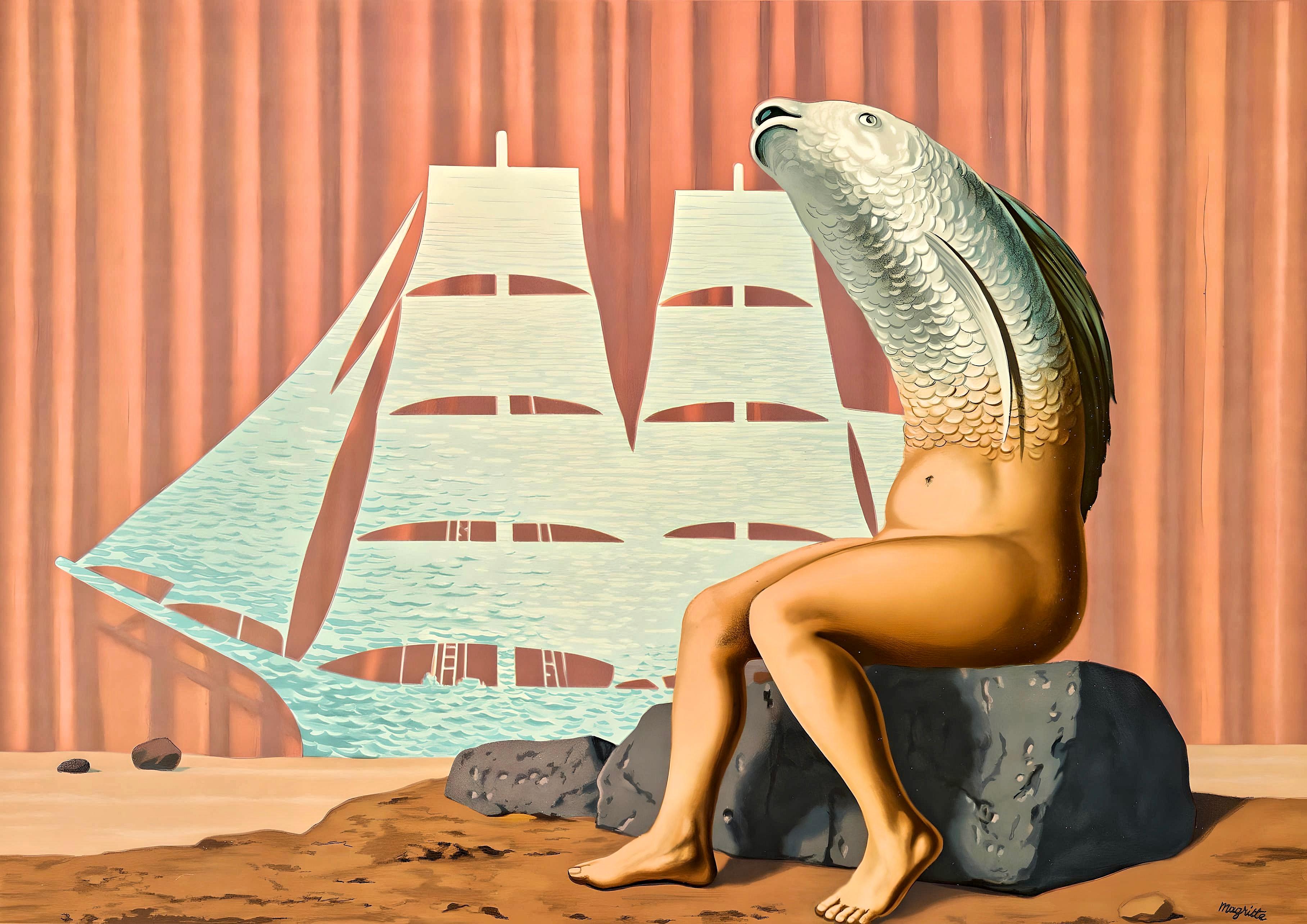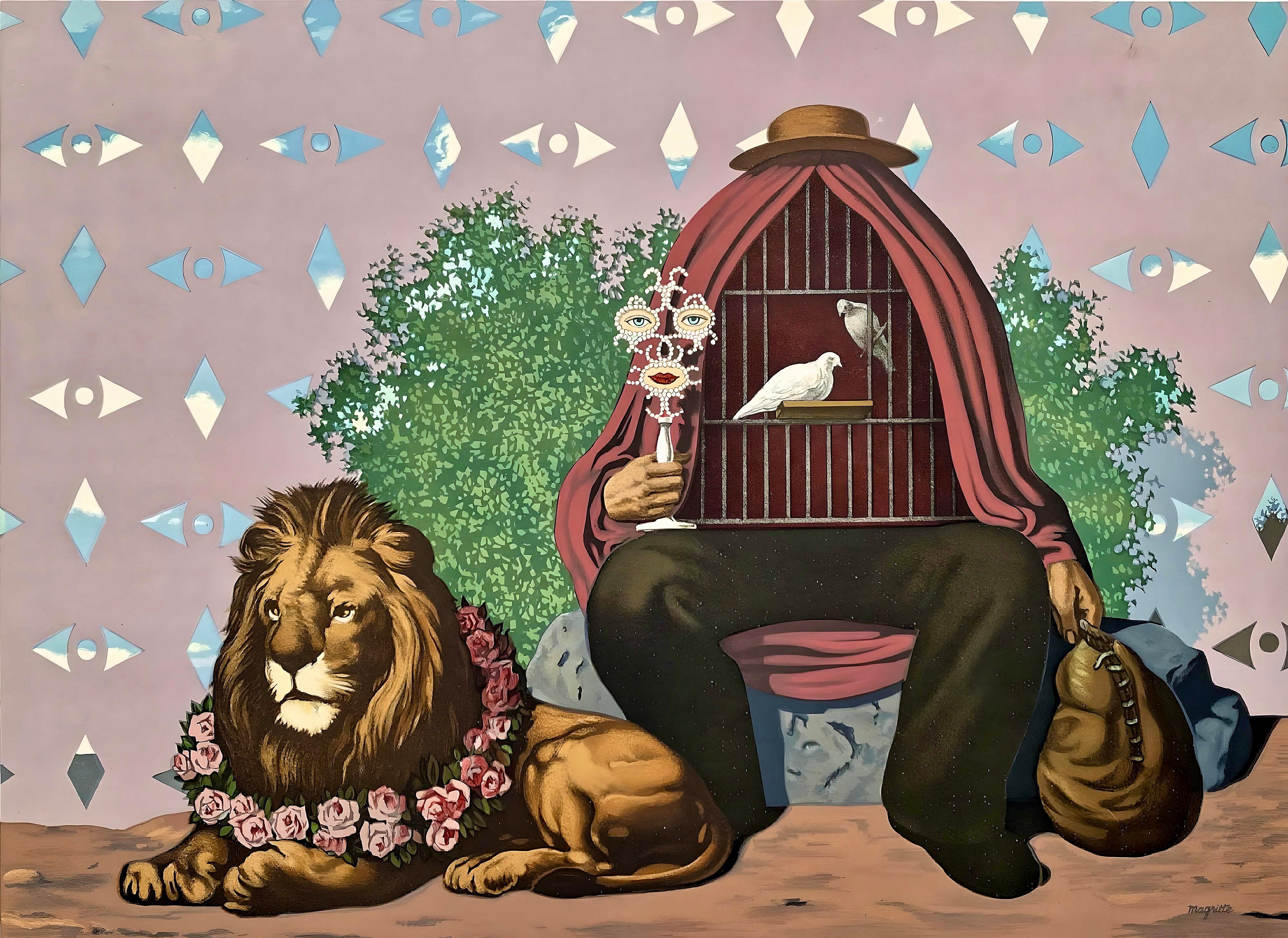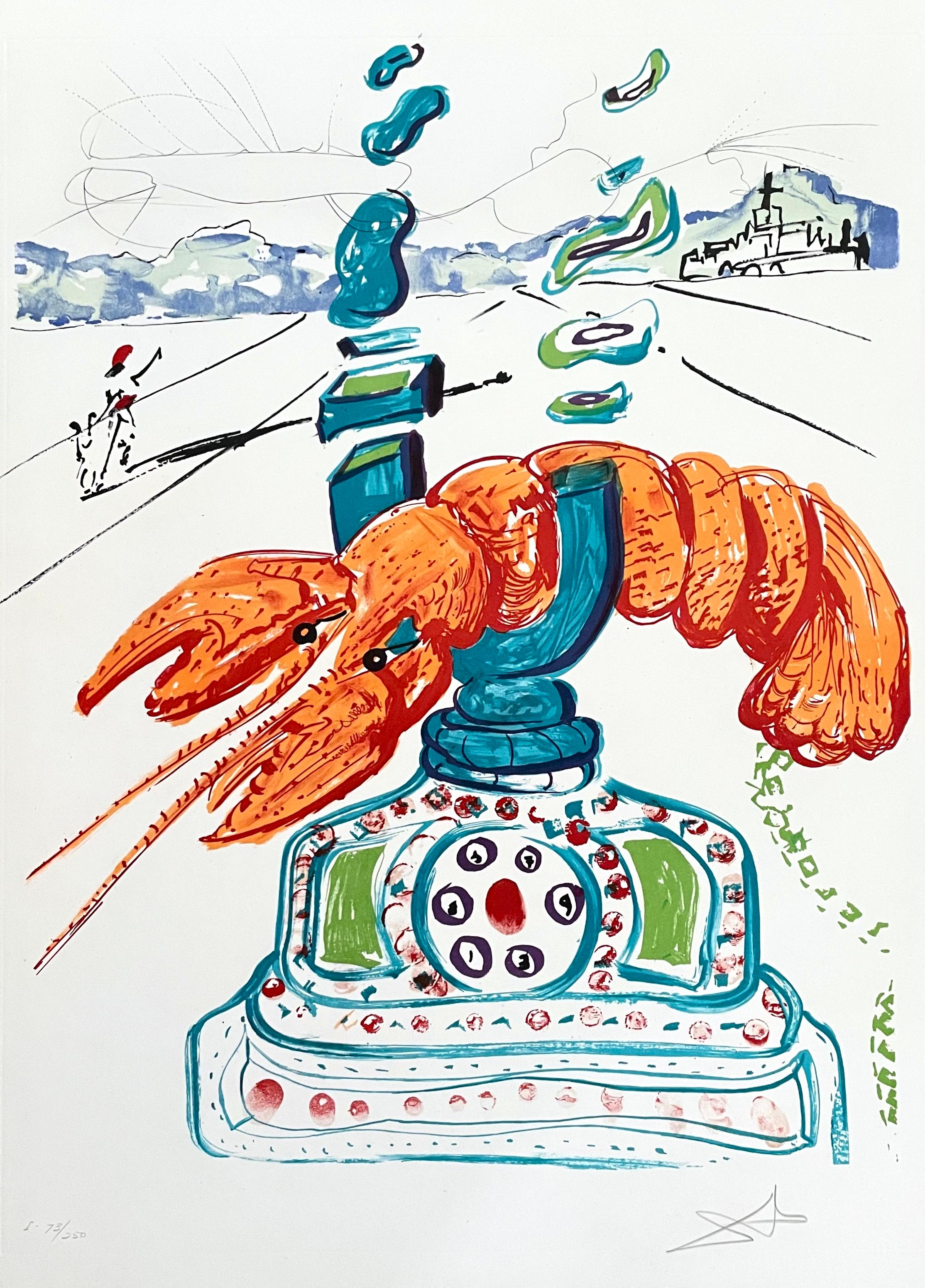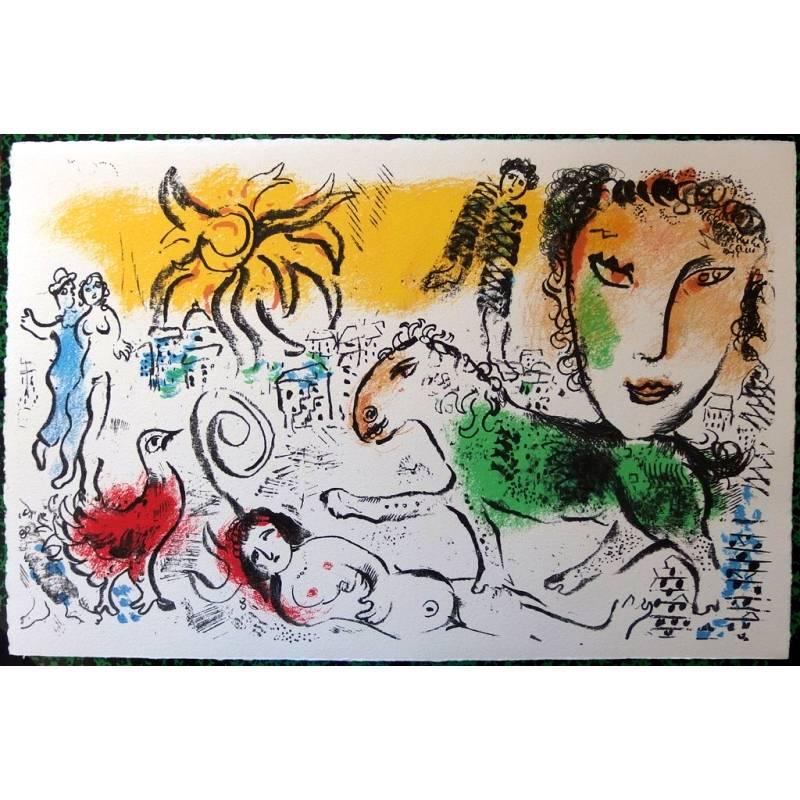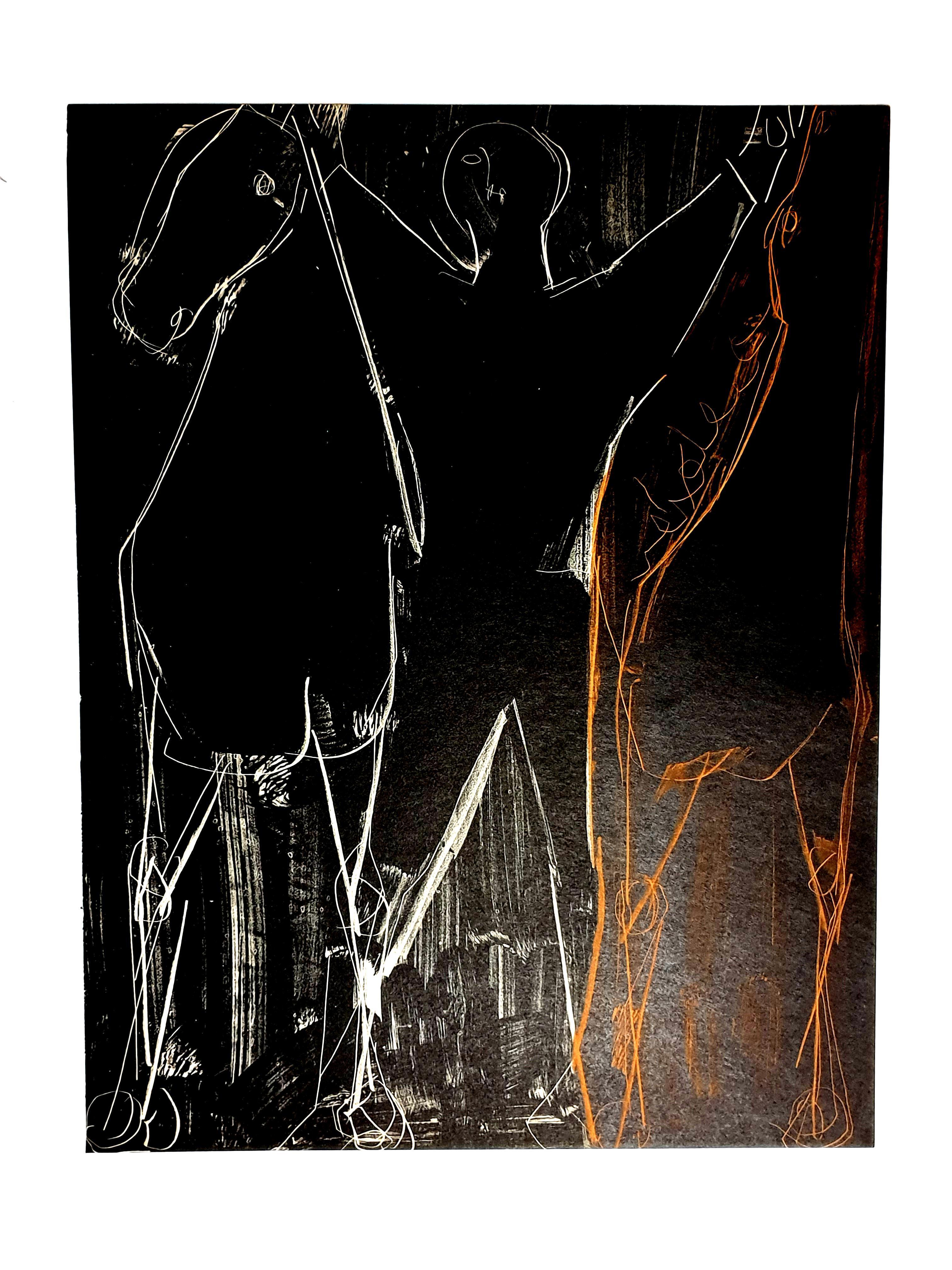Items Similar to Beetles II (With Electric Lamp)
Want more images or videos?
Request additional images or videos from the seller
1 of 12
Graham SutherlandBeetles II (With Electric Lamp)1968
1968
About the Item
This artwork titled "Beetles II (with electric lamp)" from the suite "Bestiary and some Correspondences" 1968 is an original color lithograph on Arches paper by renown British surrealist artist Graham Vivian Sutherland, 1903-1980. It is hand signed and numbered 2/70 in pencil by the artist. The sheet size is 26 x 19.75 inches, framed size is 37.75 x 31 inches. Published by Marlborrough Fine Art Ltd, London, Printed by Fernand Mourlot, Paris. Referenced and pictured in the artist's catalogue raisonne "Graham Sutherland Complete Graphic Work" by Ediciones Poligrafa, published by Edward Quinn, plate #83. Custom framed in a wooden dark gold frame, with gold color spacer and fabric matting. It is in excellent condition.
About the artist:
Graham Vivian Sutherland became a landscape painter in his mid 30s, having been a printmaker of pastoral subjects. He painted his landscapes in an abstract style, showing much interest in shapes and forms, and he experimented with Surrealism and exhibited in the 1936 International Surrealist Exhibition in London. He also did teaching in London art schools, did designing of glass, fabric and posters, and painted many portraits including Somerset Maugham and Winston Churchill, which was commissioned by the Houses of Parliament for Churchill's 80th birthday celebration in 1954. The latter commission turned into a public controversy that pitted Sutherland's modernist approach to portraiture against the Churchill's expectation that the work would depict the subject as a revered, 'international symbol.'
Sittings were done during the summer of 1954 at Chartwell, country home of the Churchill's, and the Churchill family was much charmed by the artist with a close friendship developing. However, when the portrait was unveiled in November, 1954, Churchill "took an instant loathing to it. He felt he had been betrayed by the artist, whom he had liked and with whom he felt at ease" because, according to Churchill's wife, Clementine, "it was a cruel and gross travesty of Winston, showing all the ravages of time and revealing nothing of the warmth and humanity of his nature." (Soames, 589) Because it caused Winston such dismay, his wife had it destroyed several years after it was painting. However, photographs of it survived, and because it was modernist work, many critics defended it because of its realism and the fact that Sutherland disregarded his subject as self perceived and instead, painted the aging man he saw before him.
Graham Sutherland was born in Streatham, studied at Epsom College, Surrey, and Goldsmiths College, at the University of London. He worked as an engineer at the Midland Railway Works at Derby before studying engraving at Goldsmiths College from 1921 to 1926. In 1927 he married Kathleen Barry.
During World War II, he served as an official artist and stayed primarily in England, depicting scenes of bomb damage, mining and industry.
From 1926, when he converted to Catholicism, he was deeply religious for the remainder of his life, and his convictions were often reflected in his artwork. He purchased a villa at Menton in the south of France, and spent much of his post war existence there.
There were major retrospective shows of Sutherland's artwork at the Tate Gallery in 1982, France in 1998, and the Dulwich Picture Gallery in 2005.
Works by Sutherland are held in collections and museums worldwide including, the Amgueddfa Cymru – National Museum Wales, Bristol Museum and Art Gallery, Doncaster Museum and Art Gallery, Kirklees Museums and Art Gallery, Herbert Art Gallery and Museum, Manchester Art Gallery, National Portrait Gallery, Norwich Castle Museum and Art Gallery, Northampton Museums and Art Gallery, Pallant House Gallery, Southampton City Art Gallery, The Ingram Collection of Modern British and Contemporary Art, Tenby Museum and Art Gallery, The Fitzwilliam Museum and The Priseman Seabrook Collection.
- Creator:Graham Sutherland (1903 - 1870, British)
- Creation Year:1968
- Dimensions:Height: 37.75 in (95.89 cm)Width: 31 in (78.74 cm)Depth: 1.25 in (3.18 cm)
- Medium:
- Movement & Style:
- Period:
- Condition:
- Gallery Location:San Francisco, CA
- Reference Number:
About the Seller
5.0
Platinum Seller
These expertly vetted sellers are 1stDibs' most experienced sellers and are rated highest by our customers.
Established in 1999
1stDibs seller since 2017
681 sales on 1stDibs
Typical response time: 1 hour
- ShippingRetrieving quote...Ships From: San Francisco, CA
- Return PolicyA return for this item may be initiated within 7 days of delivery.
More From This SellerView All
- "Toad I" from the suite "Bestiary and some Correspondences"By Graham SutherlandLocated in San Francisco, CAThis artwork titled "Toad I" from the suite "Bestiary and some Correspondences" 1967 is an original color lithograph on Arches paper by renown British artist Graham Vivian Sutherland...Category
Mid-20th Century Surrealist Animal Prints
MaterialsLithograph
- "Bird Form" from the suite "Bestiary and some Correspondences"By Graham SutherlandLocated in San Francisco, CAThis artwork titled "Bird Form" from the suite "Bestiary and some Correspondences" 1968 is an original color lithograph on Arches paper by renown British artist Graham Vivian Sutherl...Category
Mid-20th Century Surrealist Animal Prints
MaterialsLithograph
- "Ram's Head, Full Face" from the suite "Bestiary and some Correspondences"By Graham SutherlandLocated in San Francisco, CAThis artwork titled "Ram's Head, Full Face" from the suite "Bestiary and some Correspondences" 1968 is an original color lithograph on Arches paper by renown British artist Graham Vi...Category
Mid-20th Century Surrealist Animal Prints
MaterialsLithograph
- "Sheet of Studies" from the suite "Bestiary and some Correspondences"By Graham SutherlandLocated in San Francisco, CAThis artwork titled "Sheet of Studies, Organic Forms" from the suite "Bestiary and some Correspondences" 1968 is an original color lithograph on Arches paper by renown British artist...Category
Mid-20th Century Surrealist Animal Prints
MaterialsLithograph
- "Ram's Head" from the suite "Bestiary and some Correspondences"By Graham SutherlandLocated in San Francisco, CAThis artwork titled "Ram's Head" from the suite "Bestiary and some Correspondences" 1968 is an original color lithograph on Arches paper by renown British artist Graham Vivian Suther...Category
Mid-20th Century Surrealist Animal Prints
MaterialsLithograph
- "Frontpiece to a Bestiary" From the suite "Bestiary and some Correspondences"By Graham SutherlandLocated in San Francisco, CAThis artwork titled "Frontpiece to a Bestiary" from the suite "Bestiary and some Correspondences" 1968 is an original color lithograph on Arches paper by renown British artist Graham...Category
Mid-20th Century Surrealist Animal Prints
MaterialsLithograph
You May Also Like
- Cybernetic Lobster Telephone (Imagination & Objects), Salvador DaliBy Salvador DalíLocated in Fairfield, CTArtist: Salvador Dali (1904-1989) Title: Cybernetic Lobster Telephone (Imagination & Objects of the Future Portfolio) Year: 1975 Medium: Lithograph ...Category
1970s Surrealist Landscape Prints
MaterialsLithograph, Mixed Media
- Marc Chagall - The Green Horse - Original LithographBy Marc ChagallLocated in Collonge Bellerive, Geneve, CHMarc Chagall Original Lithograph Title: The Green Horse 1973 Dimensions: 33 x 50 cm Reference: This lithograph was created for the portfolio "Chagall Monu...Category
1970s Surrealist Figurative Prints
MaterialsLithograph
- Marino Marini - Horses - Original LithographBy Marino MariniLocated in Collonge Bellerive, Geneve, CHMarino Marini - Horses - Original Lithograph 1951 Dimensions: 32 x 24 cm From the art review XXe siècle Unsigned and unumbered as issuedCategory
1950s Surrealist Animal Prints
MaterialsLithograph
- Jean Arp - Original LithographBy Jean ArpLocated in Collonge Bellerive, Geneve, CHJean Arp - Original Lithograph 1951 Dimensions: 32 x 24 cm From the art revue XXe siècle Unsigned and unumbered as issuedCategory
1950s Surrealist Animal Prints
MaterialsLithograph
- Max Ernst - Elektra - LithographBy Max ErnstLocated in Collonge Bellerive, Geneve, CHMax Ernst - Elektra Lithograph 1939 Dimensions: 32 x 24 cm Signed in the plate From XXe siècle Unsigned and unumbered as issuedCategory
1930s Surrealist Animal Prints
MaterialsLithograph
- Max Ernst - Composition - Original LithographBy Max ErnstLocated in Collonge Bellerive, Geneve, CHMax Ernst - Composition - Original Lithograph 1958 Dimensions: 32 x 24 cm XXe siècle Unsigned and unnumbered, as issued Max Ernst was born in Bruhl, a place near Cologne, in Germany. He was raised in a strict Catholic family, and both of his parents were disciplinarians who were dedicated to training their children into God-fearing and talented individuals. Although his father was deaf, Ernst learned so much from him, particularly when it comes to painting. In fact, much of his early years were lived under the inspiration of his father who was also a teacher. He was the one who introduced painting to Ernst at an early age. In 1914, Ernst attended the University of Bonn where he studied philosophy. However, he eventually dropped out of school because he was more interested in the arts. He claimed that his primary sources of interest included anything that had something to do with painting. Moreover, he became fascinated with psychology, among other subjects in school. Primarily, Ernst's love for painting was the main reason why he became deeply interested with this craft and decided to pursue it later on in his life. During his early years, he became familiar with the works of some of the greatest artists of all time including Claude Monet, Paul Cezanne and Vincent van Gogh. He was also drawn to themes such as fantasy and dream imagery, which were among the common subjects of the works of Giorgio de Chirico. During World War I, Ernst was forced to join the German Army, and he became a part of the artillery division that exposed him greatly to the drama of warfare. A soldier in the War, Ernst emerged deeply traumatized and highly critical of western culture. These charged sentiments directly fed into his vision of the modern world as irrational, an idea that became the basis of his artwork. Ernst's artistic vision, along with his humor and verve come through strongly in his Dada and Surrealists works; Ernst was a pioneer of both movements. It was Ernst's memories of the war and his childhood that helps him create absurd, yet interesting scenes in his artworks. Soon, he took his passion for the arts seriously when he returned to Germany after the war. With Jean Arp, a poet and artist, Ernst formed a group for artists in Cologne. He also developed a close relationship with fellow artists in Paris who propagated Avant-Garde artworks. In 1919, Ernst started creating some of his first collages, where he made use of various materials including illustrated catalogs and some manuals that produced a somewhat futuristic image. His unique masterpieces allowed Ernst to create his very own world of dreams and fantasy, which eventually helped heal his personal issues and trauma. In addition to painting and creating collages, Ernst also edited some journals. He also made a few sculptures that were rather queer in appearance. In 1920s, influenced by the writings of psychologist Sigmund Freud, the literary, intellectual, and artistic movement called Surrealism sought a revolution against the constraints of the rational mind; and by extension, they saw the rules of a society as oppressive. Surrealism also embraces a Marxist ideology that demands an orthodox approach to history as a product of the material interaction of collective interests, and many renown Surrealism artists later on became 20th century Counterculture symbols such as Marxist Che Guevara. In 1922 Ernst moved to Paris, where the surrealists were gathering around Andre Breton. In 1923 Ernst finished Men Shall Know Nothing of This, known as the first Surrealist painting. Ernst was one of the first artists who apply The Interpretation of Dreams by Freud to investigate his deep psyche in order to explore the source of his own creativity. While turning inwards unto himself, Ernst was also tapping into the universal unconscious with its common dream imagery. Despite his strange styles, Ernst gained quite a reputation that earned him some followers throughout his life. He even helped shape the trend of American art during the mid-century, thanks to his brilliant and extraordinary ideas that were unlike those of other artists during his time. Ernst also became friends with Peggy Guggenheim, which inspired him to develop close ties with the abstract expressionists. When Ernst lived in Sedona, he became deeply fascinated with the Southwest Native American navajo art. In fact, the technique used in this artwork inspired him and paved the way for him to create paintings that depicted this style. Thus, Ernst became a main figure of this art technique, including the rituals and spiritual traditions included in this form of art. Pollock, aside from the other younger generations of abstract expressionists, was also inspired by sand painting of the Southwest...Category
1960s Surrealist Animal Prints
MaterialsLithograph
Recently Viewed
View AllMore Ways To Browse
Vintage Electric
Electric Vintage
Vintage Electric Lamp
Electric Sign Vintage
Vintage World War Ii Posters
Churchill Winston
Converted To Electric
Exhibition Posters 1968
Churchill Vintage
Vintage Electric Glass Lamps
Houses Of Parliament
Hand Painted Plate With Animals
Midcentury Wooden Animal
Gold Beetle
Vintage Animal Lamps
Surrealist 1936
A Sutherland
Surrealist Religious
